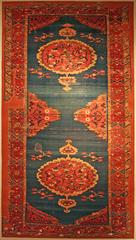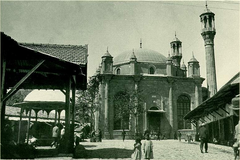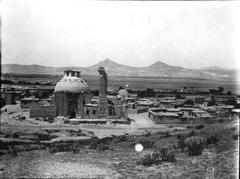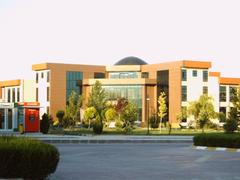
Sırçalı Madrasah Visiting Hours, Tickets, and Konya Historical Sites Guide
Date: 04/07/2025
Introduction: Discover Sırçalı Madrasah and Its Historical Significance
Sırçalı Madrasah, located in the heart of Konya, Turkey, is a masterwork of Anatolian Seljuk architecture and culture. Built in 1242 CE under Sultan Kaykaus II, it functioned both as a prestigious center for Islamic jurisprudence (fiqh) education and as a mausoleum, a reflection of Seljuk traditions that intertwined learning and commemoration. The name “Sırçalı,” meaning “glazed,” refers to the dazzling turquoise and cobalt blue tiles that decorate its portal and iwans, demonstrating Seljuk ceramic artistry and stonework.
Today, Sırçalı Madrasah is a museum housing a distinctive collection of Seljuk and Ottoman tombstones and funerary art, offering visitors insight into Anatolian funerary traditions and epigraphy. Its proximity to key landmarks, such as the Mevlana Museum and Alaeddin Hill, and its accessibility by foot, public transport, or taxi, make it an essential stop for anyone exploring Konya’s rich historical landscape.
This guide details Sırçalı Madrasah’s visitor information, including current opening hours, ticket prices, accessibility, and practical travel tips. We also highlight its architectural features, cultural significance, and nearby attractions, ensuring you have everything you need to plan a rewarding visit. For official details, refer to the Konya Museum website or the Turkish Museums portal.
Table of Contents
- Introduction
- History and Cultural Significance
- Architectural Features
- Unique Aspects
- Visitor Information
- Museum Exhibits and Collections
- Visitor Etiquette
- Accessibility and Facilities
- Best Times to Visit
- Frequently Asked Questions (FAQ)
- Visuals and Virtual Tour
- Directions
- Conclusion
- Sources
History and Cultural Significance
Commissioned in 1242 by Emir Bedrettin Muslih during Sultan Kaykaus II’s reign, Sırçalı Madrasah exemplifies Konya’s golden age as a center of scholarship and spirituality. Serving primarily as an institution for Islamic legal studies, it also housed the founder’s tomb, a tradition common among Seljuk educational complexes (GoTurkey Tourism, Turkish Museums).
Its historical role is closely tied to the rise of Konya as an intellectual hub, particularly in the context of Sufi mysticism and the Mevlevi Order, founded by Jalal ad-Din Rumi. Sırçalı Madrasah’s architectural innovations and educational legacy influenced subsequent Ottoman religious and educational structures, earning it a place on UNESCO’s Tentative World Heritage list (UNESCO Tentative List).
Architectural Features
Portal and Façade
The entrance portal (taçkapı) is a signature of Seljuk monumental architecture, projecting from the main façade and richly adorned with geometric and floral stone carvings. Its pointed arch, framed by muqarnas (stalactite vaulting) and bordered by Kufic inscriptions, is set off with alternating stone, brick, and vivid turquoise-glazed tiles—the inspiration for the madrasa’s name (ArchNet).
Courtyard and Iwans
Sırçalı Madrasah’s classic open courtyard (avlu) is surrounded by arcaded porticos on three sides and flanked by imposing iwans (vaulted halls) to the north and south. The southern iwan, larger and more ornate, likely served as the principal classroom, featuring elaborate tilework and Quranic calligraphy in Kufic script.
Student Cells and Upper Floor
The original two-story structure accommodated student rooms (hücreler) on both levels around the courtyard. Many original cells were lost after the 17th-century abandonment, but restoration has preserved key spatial features and incorporated 19th-century additions.
Decorative Elements
Throughout the madrasa, intricate arabesques, geometric motifs, and calligraphic bands are combined with extensive turquoise-glazed tilework. The southern iwan’s mihrab (prayer niche) is particularly notable for its tile mosaic and carved stone decoration.
Construction Techniques and Materials
Constructed with finely dressed limestone and brick, Sırçalı Madrasah exemplifies Seljuk engineering prowess. The glazed tiles were produced using advanced ceramic techniques, while pointed arches and barrel vaults provide both strength and architectural drama. Several restoration campaigns in the 20th century have stabilized the structure and enhanced its museum function.
Unique Aspects
Sırçalı Madrasah stands out as the only surviving two-story, open-courtyard madrasa in Konya with three-sided porticos and two iwans. Its extraordinary use of glazed tilework distinguishes it as a masterpiece of Seljuk decorative arts. The presence of a restored Byzantine catacomb in the garden adds an additional historical dimension for visitors.
Visitor Information
Visiting Hours
- Open: Daily, 9:00 AM – 5:00 PM (last entry at 4:30 PM)
- Closed: Mondays and national public holidays (check before visiting, as schedules may vary)
Ticket Information
- Entrance Fee: 50–100 Turkish Lira (as of 2025), with discounts for students, children, and Turkish citizens
- Combination tickets may be available for nearby sites, such as Ince Minaret and Karatay Madrasah (Turco Travel)
- Tickets can be purchased at the entrance or online via the official museum website
Guided Tours and Accessibility
- Guided tours provide deeper insight into Seljuk history and art—arrange on-site or via local operators
- The courtyard and ground floor are wheelchair accessible; however, some upper levels and rooms may be inaccessible due to historic preservation
Special Events
Occasionally, Sırçalı Madrasah hosts cultural events, workshops, and temporary exhibitions focusing on Seljuk heritage. Check the museum’s official calendar for updates.
Museum Exhibits and Collections
Since 1956, the madrasa has served as the Museum of Stone and Wood Works (now the Grave Monuments Museum), displaying a unique collection of Seljuk and Ottoman tombstones, wooden artifacts, and inscriptions. The museum’s highlights include:
- Seljuk-era tombstones with geometric and floral motifs
- Ottoman gravestones featuring elaborate calligraphy
- Examples of original tilework and epigraphy
(Konya Culture and Tourism Directorate)
Visitor Etiquette
- Dress modestly, covering shoulders and knees, out of respect for the site’s heritage
- Maintain a quiet and contemplative atmosphere
- Photography is allowed in most areas without flash or tripods; check for signage indicating restrictions
- Do not touch artifacts or architectural details
Accessibility and Facilities
- The site’s historic character means some uneven paving and steps; wheelchair access is possible in the courtyard but limited elsewhere
- Restrooms are available nearby; no on-site café or shop, but many options are within a short walk
Best Times to Visit
- Weekday mornings offer the most peaceful experience
- Spring (April–June) and autumn (September–November) provide mild weather for comfortable sightseeing
- During the annual Mevlana Festival in December, Konya is busier; visiting outside of festival periods is recommended for a quieter experience
Frequently Asked Questions (FAQ)
What are the visiting hours?
Open daily 9:00 AM – 5:00 PM, last entry 4:30 PM. Closed on Mondays and national holidays.
How much are tickets?
50–100 TL (2025), with discounts for students and children. Tickets available on-site and online.
Is the site wheelchair accessible?
The courtyard is accessible; some areas are not due to the historic structure.
Are guided tours available?
Yes, through local operators or by arrangement with museum staff.
Is photography allowed?
Yes, except for flash and tripods.
Visuals and Virtual Tour
Access high-resolution images and an immersive virtual tour on the Konya Museum’s official website.
Directions
Sırçalı Madrasah is located in Konya’s historic Sahibiata neighborhood, within walking distance of the Mevlana Museum and Alaeddin Hill.
- By foot: 10–15 minutes from major sites
- By public transport: City buses and trams serve nearby stops
- By car: Limited street parking available
Google Maps Location – Sırçalı Madrasa
Nearby Attractions
- Ince Minaret Madrasah: Renowned for its slender minaret and stone and woodwork collections (Turco Travel)
- Karatay Madrasah: Home to the Tile Museum, displaying Seljuk ceramics (Istanbul Points)
- Alaeddin Mosque: The oldest mosque in Konya, atop Alaeddin Hill
- Mevlana Museum: Mausoleum of Rumi, spiritual heart of Konya
A half-day walking tour can encompass Sırçalı Madrasah and these landmarks for a full introduction to Seljuk Konya.
Practical Visit Tips
- Combine visits with other museums for savings; combination tickets may be available
- Most signage is in Turkish and English; basic English is spoken by staff
- Dress for the season—summers are hot, winters cold
- Bring water and wear comfortable shoes for uneven surfaces
- Konya is safe and tourist-friendly; standard precautions are advised
Conclusion
Sırçalı Madrasah is a remarkable testament to Konya’s Seljuk heritage, offering a rich blend of architectural splendor, historical depth, and cultural resonance. Its iconic glazed tiles, monumental portal, and museum collections make it a must-see for architecture enthusiasts, historians, and cultural travelers alike.
Plan your visit by checking the latest hours and ticket options via the official museum website or local tourism resources. Consider exploring the site virtually in advance, and utilize guided tours for deeper insight. For ongoing travel inspiration and updates on Konya’s cultural sites, download the Audiala app and follow our social media channels.
Embark on your journey to Sırçalı Madrasah and immerse yourself in the enduring legacy of Konya’s medieval past.
Sources and Official Links
- Konya Museum Website
- Turkish Museums Portal
- GoTurkey Tourism
- Konya Culture and Tourism Directorate
- Anatolia Travel Services
- ArchNet
- Turco Travel
- Istanbul Points
- UNESCO Tentative List
Related Internal Links:







